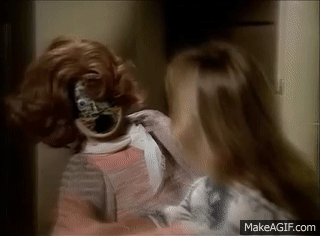Felice Grodin
AdrienneRose Gionta
Felice Grodin and AdrienneRose Gionta have collaborated on several projects. In 2015 they explored real estate speculation and virtual environments in the group exhibition Residential Properties. Currently, they are featured at Miami International Airport in the exhibition IM|Movable Assets. The exhibition explores what an experience might be at MIA in 500 years post-climate change. Additionally, they enjoy discussing the potentials and pitfalls of love on the internet and how bodies come together in virtual space. This has led to a fundamental question for both:
What is the history of the female cyborg, and how can she/they adapt for a better future?

“I've just met a girl named Maria
And suddenly that name
Will never be the same
To me
Maria!”
1984 marks the midpoint of the two bookends of our research/investigation. It is the year of the seminal essay A Cyborg Manifesto by Donna Haraway. The first bookend: 57 years prior (1927) marked the beginning of the popular depiction of the female body fused with technology in the Fritz Lang film Metropolis. The second bookend: 57 years after Haraway’s essay, we will explore the trope of the female cyborg in popular culture as well as alternative depictions. We will also pivot to more speculative iterations between the years 2020-2041.
There are (3) critical postulations exemplified by Haraway’s essay that will comprise the jumping point of the research:
-
Transgression in the boundary between human and animal (Affirmation of connection between human & other living creatures)
-
Ambiguity in distinctions among animal-human-machine (Uncertainty of what accepts as nature)
-
Boundary between physical and non-physical is imprecise (Machines and microelectric devices are everywhere and invisible)

Thus how have these (3) points manifested in both popular culture and visual art? Have they been met, eclipsed, surpassed and/or widened? In addition, what are the social/political ecologies where these points have developed, and what critiques can be applied? Thus can the speculative nature of the essay at the time it was written, alternately be expanded in the future in a way that is still emancipatory?
Our research will comprise of: reading additional applicable text, watching applicable video, consulting applicable people who are similarly interesting and/or researching such material, recording and collecting applicable material both visual and audio, classifying collected research material, finally: mapping previous, current and new trajectories of the research.


Hybrid Enviroscape TEST 1
Collage is not a new medium. But in the digital age how can binary subject/object dissolve or at the least teeter within the trope of The Cyborg? Or conceivably it is the opposite. Perhaps it’s not the dissolutions of edges but the very definition of them that enables the act of mutation as such. Hybrid_Enviroscapes explore this meeting point as a spatial deceleration.
In TEST 1: A Hybrid is born from an egg. A blue egg with a 3D isoline protocol. Out of it, springs arms (splines) that spiral and enable it to hover. It’s looking for a home and has found one. In this land, it is able to stretch and flicker its tentacles within an Enviroscape, which is, in turn, flickering as well. This Enviroscape developed within the universe of Second Life with the grafting of glitter|i| from the Cyborg Salon. This is a good match! In celebration, there is a warm welcome [in Wing Dings]. A conversation has begun between the Hybrid and its Enviroscape, enveloped within an audio mutation of a Ted Talk with Jane Fonda and Lily Tomlin + Love in the Future + Meet Q, The Gender-Neutral Voice Assistant
Felice Grodin
Felice Grodin is an artist with a background in architecture. Her practice focuses on the speculative integration of art by modeling present conditions and creating meaningful imprints upon them. She was recently featured zon Felice Grodin: Invasive Species on view at the Pérez Art Museum Miami (PAMM), curated by Jennifer Inacio. The work mediates a future ecosystem through the lens of augmented reality. She is a member of the collaborative A.S.T. (Alliance of the Southern Triangle), which explores artistic and cultural possibilities reimagined in an era of climate change and political volatility. She has also contributed essays to various publications including The Miami Rail. Felice obtained her Bachelor of Architecture from Tulane University, where her thesis was a recipient of the Thomas J. Lupo Award for Metropolitan Studies, and her Master of Architecture with Distinction from Harvard University.


AdrienneRose Gionta
AdrienneRose Gionta, aka VJ_ARG_A_LICIOUS, works in performance, film/video, sculpture, drawing, and installation. Her work explores notions of fatness, embodiment, and fulfillment in “real” and online spaces. She examines how body image mediates our access/relationship with pleasure, ambiguating the distinction between notions of utopia and dystopia through subverting and re-appropriating preexisting codes or “carrying on” multidimensional histories driven by the fear of it all disappearing into never existing when everything dies. She summarizes her position within, and as: Pop Culture Consigliere, VJ soothsayer, Rose Whisperer, Digital Ideation Butterfly and Extended Reality Evangelist. Tumblr Virtuoso, Internet of Things Svengali and 50 Shades of Earl Grey.




